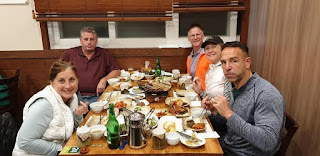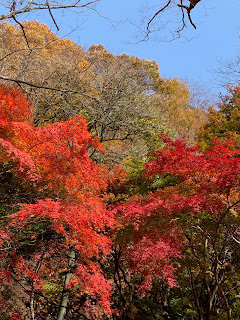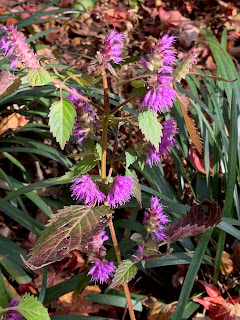If autumn could be summed up in one picture, or about a hundred individual pictures, it would be from Naejangsan National Park. Naejangsan is famous in Korea for being the best place to view the most beautiful colors that autumn has to offer. When my friend Sarah asked if we wanted to tag along with them and the Sloans, of course we were in!
When we arrived, this was the first view our eyes feasted upon:
The rain was not cooperating with us, but that did not stop us from seeing what we came to see.
The heavy clouds didn't do a lot for visibility, but they added an air of mystery to the pictures.
Baegyangsa Temple is located at the base of Baegamsam Mountain. It is said to have been founded in 632 and many esteemed Buddhist monks and scholars of Korean history have stayed here.

Actual Buddhists know their way around inside these temples; to my untrained eye, they all look pretty much the same inside.
This little building is called the Gate of Heavenly Kings. There are four statues, or heavenly kings, who guard the four cardinal directions where the Buddha resides. They are distinguished by which direction they guard and what they hold. Collectively they hold a lute, a sword, a dragon with a wish filling-jewel, and a stupa. Of course these all mean something special regarding the Dharma. The heavenly kings take care of the people by bestowing blessings on the good and misfortune on the bad.The area is known for its many Bodhi trees. The name is a Chinese translation of Sanskrit, or an Indian poem, and means wisdom by enlightenment. A Buddhist monk Sakyamuni learned from under the tree. The leaves are heart shaped. The temple area is also known for the Japanese Torreyas trees. These Japanese tress were planted in the late Goryeo Dynasty (late 1200s to mid 1300s) for the many uses of its wood and berries.
The bigs had kids their age with us on this trip, but Lijee didn't so we brought along his friend Alex.
From here we started the Baekyangsa Walking Trail.
Yaksaam Temple was the first sight along the trail.

The teens made it up first and were waiting on us old people to catch up.Most of us continued on up from there towards the Yeongcheongul Cave. Around the time of the American Revolution during the late Joseon Dynasty, King Yeongjo ordered someone to go to Yeongji and pray loudly. It is said the ill were cured by drinking mineral water from this rock cave. Thus this hermitage was built around the cave. People still drink healing waters from the cave.The original hermitage was burned and rebuilt in the last few years. There are only steep stairs leading to the cave, so I have no idea how they got the materials there. Past that began the stairs. Abe, Troy, Zeke and Alex were ahead of Daisy, Sarah and I. Alex was proud that he finished the round trip right at 30 minutes faster than us girls.
Around the time of the American Revolution during the late Joseon Dynasty, King Yeongjo ordered someone to go to Yeongji and pray loudly. It is said the ill were cured by drinking mineral water from this rock cave. Thus this hermitage was built around the cave. People still drink healing waters from the cave.The original hermitage was burned and rebuilt in the last few years. There are only steep stairs leading to the cave, so I have no idea how they got the materials there. Past that began the stairs. Abe, Troy, Zeke and Alex were ahead of Daisy, Sarah and I. Alex was proud that he finished the round trip right at 30 minutes faster than us girls. The way down is so much easier! I actually got a smile.
The way down is so much easier! I actually got a smile. 

I read one legend about a famous Buddhist monk teaching at the cave in the late 1800s with many people coming to listen. On the 3rd day of the sermons a white sheep came to listen from the peak of Mt. Beakhak. After the 7th night when the sermon was over, the monk had a dream of a white sheep visiting him, stating that because of his sins he was reborn a sheep; after hearing his teachings he had been reborn and returned to heaven. It bowed and disappeared, but the next morning a dead white sheep was found on the floor of the cave. It is claimed after this that the temple at the base of the mountian was renamed to Baekyang-sa.
So. Many. Stairs.We were so high that we were above the clouds.
Near the peak we ran into the guys on their way back down.
We finally made it past Hakbawi Rock to Baekhakbong Peak, at 651 meters.Near the peak we ran into the guys on their way back down.

And then in those few minutes that we lingered at the top to snap a couple pics, the clouds began to clear. We could actually begin to see the village below.

Time for some lunch!
Look! Eli found a stick.
Look! Eli found a stick.
He also found a leaf with all the colors of the fall rainbow.

I love the bright green color of the moss.
You can see how much the clouds lifted by comparing this picture from the starting place at the bottom.

From the Baekyangsa Temple we found our hanok located in the Juknokwon Bamboo Garden which spans 310,000 square meters. The bamboo garden was cultivated behind the Danyang Hyanggyo Confucian school in 2005. It is known as one of Korea's best bamboo gardens.
Upon check-in they wisked us away to our hanok in a golf cart. By the time we got all of our luggage and all 6 of us plus another worker and the driver, the buggy was quite full. I was squeezed in the front seat between the two ladies.
What is a hanok? It is a traditional Korean house. The shapes differ by region. They are constructed from natural materials and are touted to be 100% biodegradable and recyclable. Some standing hanoks are claimed to be 500 years old. These were definitely not that old. But the kids were fascinated.

After about 30 minutes of running in circles and closing and opening doors/windows and hiding and zeking, they settled down and screened up. Notice the lack of furniture. And beds.
We didn't sit for long though. The Blosches, Andre-Sloans and us checked out what the bamboo forest had to offer. 



 |
| Sarah, Ed, Trish, Aaron, Emily, Alex, Sebastian, Eli, Troy, Caroline, Zeke, Daisy, Abe (Mathieu not pictured) |


We found some arrow chucking and a couple big swings.

We only got to see a small part of the bamboo garden because Sarah had made dinner reservations for us.
 |
| Zeke, Emily, Sebastian, Aaron |
 |
| Mathieu, Daisy, Eli, Alex |
 |
| Trish, Troy, Ed, Sarah, Abe, (Caroline taking the pic) |
As with all traditional Korean meals, there were a million little plates filled with all kinds of Korean-tasting foods. The specialty in the area is tteokgalbi, which is marinated beef patties.
The next morning the grownups got up early and took a walk around the bamboo forest because that's what old people do.


It is often called bathing in the bamboo forest. Apparently bamboo soaks up four times the amount of CO2 as pine trees, so the oxygen in the bamboo forest is more concentrated. Because of this, bamboo trees are said to help relieve stress, relax muscles, soothe your mind, increase happiness and improve brain function. According to this info, I should have felt like a million bucks after that walk!

There are 8 different walking paths: Good Luck Road, Meditation Road, Old Friend's Trail, Lovers' Lane, Philosopher's Way, Old Memories Byway, Seonginsan Trail, and Scholar's Road.
Look at this cool lamp post.
Some of you don't get to see the fun side of Abe, but there is one in there that comes out when he thinks you're not looking.
 [November 1]
[November 1]
These pandas 'receive the energy of Damyang to protect and care for the great forest with a mysterious power.'

When we got back from our walk the children were still asleep until we opened the window/doors.
After sharing breakfast with our friends we headed for the Naejangsan Nature Observation Course. It was quite a bit easier than the day before, but just as beautiful with its kaleidoscope of leaves. On the way we exercised our Texan heritage by stopping along the side of the road to take some pictures, just like the Texans do for blue bonnets.
Between the parking lot (you know this is a well-visited place if there is actually a parking lot) and the entrance to the trail, we passed the marketplace where the streets are lined with many little vendors selling Korean-style carni snacks like gun bam and hotteok, or something with a more Western feel like corn dogs and these tornado twister type things. As soon as we passed the booths and hit the trees, the views were amazing.
I love that little leaf that just happened to be falling and captured in my picture.

It's harder to get family shots when we're with other people, but I got them all of DanFam5 rounded up for just a second.
These are some of our people...Sarah, Zeke, Aaron and Sebastian.
There's Eli...with a stick.
 That's Daddy, Daisy, Lijee and Alex on the bridge.
That's Daddy, Daisy, Lijee and Alex on the bridge.
 That's Daddy, Daisy, Lijee and Alex on the bridge.
That's Daddy, Daisy, Lijee and Alex on the bridge.He got all three of them carrying sticks!
 That blue roof in the back is Uhwajeong Pavilion. Legend has it that it once grew wings and ascended to the heavens.
That blue roof in the back is Uhwajeong Pavilion. Legend has it that it once grew wings and ascended to the heavens.


 The Gate of Heavenly Kings, just like the one at Baekyangsa Temple with the guardians inside.
The Gate of Heavenly Kings, just like the one at Baekyangsa Temple with the guardians inside.

 There are many buildings that make up Naejangsa Temple. The original temples were built in 636, but much like the rest of Korea, they have been destroyed and rebuilt several times.
There are many buildings that make up Naejangsa Temple. The original temples were built in 636, but much like the rest of Korea, they have been destroyed and rebuilt several times.



 That blue roof in the back is Uhwajeong Pavilion. Legend has it that it once grew wings and ascended to the heavens.
That blue roof in the back is Uhwajeong Pavilion. Legend has it that it once grew wings and ascended to the heavens.

 The Gate of Heavenly Kings, just like the one at Baekyangsa Temple with the guardians inside.
The Gate of Heavenly Kings, just like the one at Baekyangsa Temple with the guardians inside.
 There are many buildings that make up Naejangsa Temple. The original temples were built in 636, but much like the rest of Korea, they have been destroyed and rebuilt several times.
There are many buildings that make up Naejangsa Temple. The original temples were built in 636, but much like the rest of Korea, they have been destroyed and rebuilt several times.


This is 108 Danpung Tunnel, so named because it is lined with 108 maple trees. There is Buddhist meaning behind it: the number 108 is the symbol for the wordly feelings and desires Buddhist hermits must remove.
I am summing up all these fall leaf pictures with one of my favorite flowers, daisies, amongst the colorful leaves.



















































































































































No comments:
Post a Comment